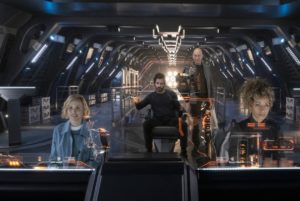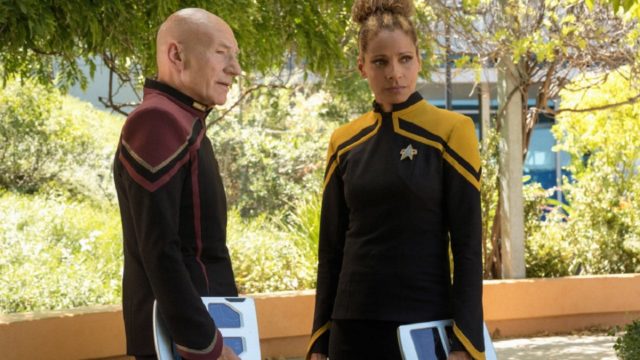After the first episode, “Remembrance”, I’d thought maybe I’d write a review for each episode of Star Trek: Picard, but the second episode, “Maps and Legends”, didn’t feel like it needed a review. It wasn’t a bad episode, and certainly I didn’t expect it to be as good as the first episode as it was a hard act to follow, but it was mostly a moving-the-pieces-into-place episode, without much of a narrative arc.
The third episode, “The End is the Beginning”, jumped the quality back up and made me decide to cover both of them at once.
I figure if you haven’t watched the first episode, or if it didn’t grab you, then you’re not likely to be reading this, so I’m just going to jump to spoilers after the cut:
“Maps and Legends” opened with a pretty boffo flashback scene of the synthetics rebellion on Mars 14 years earlier, leaving us with more questions (Were they hacked? Did they rebel? What was the goal?). But the rest of the episode is divided between two parts:
First, Picard trying to track down Dahj’s sister, which involves examining her apartment (I think remotely, although the scene is awkwardly filmed), appealing to Starfleet to be reinstated – he’s brusquely denied – and then contacting an old associate as an alternative.
Second, Dahj’s sister, Soji (also played by Isa Briones), is a researcher on the Borg cube, who is sleeping with Narek (Harry Treadaway), who is also the head of the proceedings there. Borg drones are being freed from the collective, and their implants are being harvested. It also seems to be a multi-racial effort, and it’s not yet clear how in-the-clear this work is. We also learn that Narek is working for his sister, Lt. Rizzo (Peyton List), who is a Romulan spy in Starfleet who in turn is working for Commodore Oh (Tamlyn Tomita). It’s not clear whether Oh is Vulcan or Romulan.
“The End is the Beginning” opens with another flashback, in which the synthetics rebellion caused Starfleet to close down the Romulan refugee evacuation, and Picard tried to force them to change their minds but instead they accepted his resignation. His XO, Raffi (Michelle Hurd), was also fired. In the present day he asks for her help. She is still massively angry with him, but puts him in contact with a pilot, Chris Rios (Santiago Cabrera). She also believes she has proof that a Starfleet conspiracy okayed the synthetics rebellion.
Commodore Oh contacts Dr. Agnes Jurati (Alison Pill), the artificial intelligence scientist Picard had talked to in the first episode, after which Picard and his housekeepers – former Romulan intelligence – are attacked by the squad that killed Dahj. (The notion that they have guns hidden all over Picard’s house is great!) This leads to Picard and Jurati leaving with Rios, with Raffi joining them at the last minute, following her own leads.
Meanwhile, former Borg drone Hugh (Jonathan Del Arco, who played Hugh in Star Trek: The Next Generation) helps Soji interview a Romulan who had been freed from the Borg collective, but whose mind is in a poor state. She accuses Soji of being “the destroyer” and attempts to kill her.
The best parts of “End” are the character bits on Earth. In particular, I appreciate that Picard is shown as being still a capable leader, yet also fallible in a way we rarely saw in NextGen. His miscalculation with Starfleet is humiliating, and his unwillingness to believe Raffi 14 years ago likely has cost him – and Starfleet – in ways we don’t know yet. In the wake of this failure, his assessment of Rios as “Starfleet through and through” is staged with just enough of a pause to make us think he might be wrong again, but he’s not. In a way this is consistent with the character’s past: Picard’s strengths were his ability to assess individuals, and his strong moral sense. His ability to handle politics – in Starfleet or in larger venues – were not where he wanted to spend his time, and always seemed a bit haphazard. One suspects that Picard’s career was partly the result of a Starfleet that was sympathetic to the man he was, and that things are different now.
Raffi and Rios are also vivid characters, despite not getting a lit of screen time. Hurd gets more of an opportunity and knocks it out of the park. Rios has a little of that Han Solo swagger, but I bet if you were to ask him that old Steve Jobs question, “Why join the navy when you can be a pirate?” he’d ask why you couldn’t do both. Cabrera mainly chews the scenery here – and does a good job of it – but I bet he’ll have more opportunity to show what he can do later.
(Alison Pill has quite a challenge ahead of her, shoehorned in among these three, playing a character who is clearly out of her depth. I’m also a bit sad to say goodbye to Orla Brady and Jamie McShane as Laris and Zhaban, Picard’s housekeepers, as they also both did a great job in their limited screen time. If it was explained why they’re not going with Picard, I missed it.)
These scenes in “End” contrast with the scenes on the Borg cube in “Maps”, where, frankly, neither Soji nor Narek are all that interesting. Soji is a professional doing a job, albeit an unusual one. Narek is a spy with prosaic motivations. Their story gets a little more interesting when Soji interviews the former drone in “End”, but it’s all plot-based. Briones doesn’t have nearly as much acting to do as she did as Dahj, although that might change soon now that she suspects something happened to her sister. There’s potential here, but so far the character moments on the cube have been rather ho-hum.
Another nifty thing about the story is that it’s applying the “rag-tag party on a quest” trope to Star Trek, where Picard and company are certainly not the top-of-the-line Starfleet officers in a Federation starship, but rather they’re heading into who-knows-what danger, with little real idea of the forces acting around them. Picard is looking for Soji, Raffi is looking for evidence of a conspiracy within Starfleet, and most likely those two are going to dovetail before the story’s done.
I feel like the story pushes a little too far over the plausibility line in some of its people-who-aren’t-who-they’re-pretending-to-be plot elements. Romulans and Vulcans aren’t the same, and it’s hard to believe Romulans could infiltrate Starfleet, who presumably would carefully scan all of their officers. Of course, maybe the conspiracy goes really high up, but if not, then I’m not sure how Rizzo hasn’t been found out. And if Oh turns out to be a Romulan then the whole story is going to seem rather silly. (This is one of those concerns that seems more obvious in today’s world than it would have before 9/11.) How Dahj and Soji have managed to evade detection is also curious, although it seems Dahj’s identity is only a few years old, so if she and Soji had kept their heads down they could have avoided being found out in that time. It’s also implied that they’re a rather different kind of synthetic, arguably more advanced than Data in both their emotions and their physical form. So there’s a lot we don’t know.
All told, though, there are a lot of moving pieces here, a lot of external threats and personal demons to work through to bring this story to ground. At this point it looks like Picard, Raffi and Soji are going to be the main characters in this story, and Picard and Raffi in particular have a lot to work through both individual and between each other. The first act of this season is over, and now it’s time to start working through the issues which have been set up.
(I wouldn’t mind some more meaningful episode titles, either. The ones for these first three have been pretty generic.)
- Previous review: Remembrance (episode 1)
- Next review: Absolute Candor (episodes 4 & 5)


